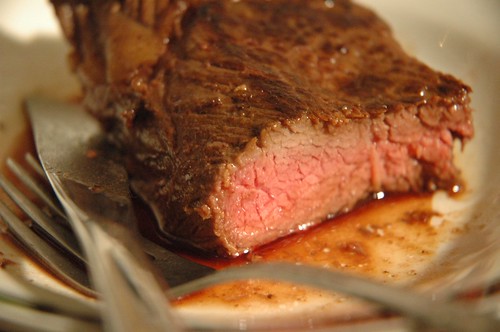Hello there, readers! I'd like to start off by apologizing for not posting for a few days. It was a pretty hectic weekend and while I did do some dining out and about, none of them were noteworthy enough to mention here, unfortunately. I think the best food I ate this weekend was at my friend Heidi's house, where we celebrated our friend's baby shower, and Heidi hosted...she's such a great entertainer, and a wonderful cook!
Today was a laid back day, and I finally had time to prepare a meal at home again - it's been a few days so it was great to get back into the kitchen! Tonight, we are having Honey-Glazed Pork with Wilted Greens. I got this recipe from Martha Stewart Living Magazine a few years ago and have made it a few times since then. It's a foolproof easy dinner, and it's delicious!
a few years ago and have made it a few times since then. It's a foolproof easy dinner, and it's delicious!
Let's get our mise en place in place. You'll need:
2 teaspoons Dijon mustard
3 1/2 tablespoons red-wine vinegar
4 tablespoons raw honey
1 large garlic clove, finely chopped
1 teaspoon coarsely chopped fresh rosemary
1 tablespoon plus 4 teaspoons olive oil
1 3/4 pounds pork tenderloin
3/4 teaspoon coarse salt
freshly ground pepper
1 large fennel bulb, trimmed and sliced lengthwise into thin strips
1/2 head escarole, cut into 2-inch strips
1/2 pound spinach, washed well
It's a pretty simple prep right off the bat, huh? The first thing I did was preheat my oven to 375 degrees Fahrenheit. In a small bowl, whisk together 1 teaspoon mustard, 2 tablespoons red wine vinegar, 2 tablespoons honey, garlic, rosemary (I ran out of rosemary, so I used some dried thyme - not AS flavorful, but it works) and 2 teaspoons oil.
Once your glaze is made, place your pork tenderloin into a shallow baking dish and pour the glaze on top. Flip the pork a few times to coat all sides really well and then sprinkle the top with a generous amount of salt and pepper. Roast the loin in the oven for 30 - 35 minutes (until the thickest part reaches 155 degrees on a meat thermometer). Spoon the glaze over the pork occasionally as it cooks.
Once you pull the meat out of the oven, you want to let it rest for 5-10 minutes before cutting into it. If you are using a meat thermometer, you want it to read 160 degrees before you cut into it. Check out my post on The Resting Period for more info on this process!
While the pork is resting, make the vinaigrette for your greens by whisking together 2 tablespoons honey, 1 1/2 tablespoons vinegar, and 1 teaspoon mustard. Whisk until the honey is dissolved and then slowly add a tablespoon of olive oil into the mix until it is emulsified well. If you want, you can also whisk in any cooking juices from the dish the pork is in.
Add 2 teaspoons of oil to a large saute pan, along with a splash of water. Add the fennel, escarole and spinach to the pan and cook until the greens are wilted, about 1 1/2 minutes.
Like the other night, this large amount of greens will wilt down to about a third of this size. Once that has happened, add the vinaigrette along with some salt and stir the greens to coat, about 30 seconds. Remove from the heat immediately.
I let my greens sit for an extra minute in the pan and they got a little over-cooked, so once they are done, make sure to plate them immediately so they are removed from the heat. Slice the pork about 1/2 an inch thick and arrange on the plate with the greens. Tah-Dah!









